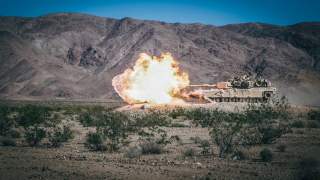How to Build a U.S. Marine Corps Base Out of 40,000 LEGOs
That's innovation for ya.
LEGOs—those plastic building blocks of creation—have been used to design many strange things, from giant Star Wars destroyers to World War II battlefields.
But a U.S. Marine Corps airbase?
Paul Thomas, a California realtor, has actually created a 75-square-foot replica of a Marine installation that resembles the real Marine airbase at 29 Palms, California.
But to call what built Thomas built a mere “replica” is an understatement. Not with a LEGO set that includes F-35 fighters, vehicles with flashing lights—and even a Porta-Potty (you can see the video here). Thomas estimates the set uses 30,000 to 40,000 LEGO blocks.
Thomas did it to honor the Marine Corps. “I was unable to serve due to Type 1 diabetes,” Thomas told the National Interest. “Both my dad and stepfather were Marines in their younger life. Also, we have property that we camp on that’s in 29 Palms. Anytime we are out there, the Marines at 29 Palms are training. MV-22’s fly over us at night and you can hear explosions going off. So I just wanted to give a nod to the Marine Corp in this build.”
And what a tribute it is. Where to begin? The LEGO Marine base, shown at the Bricks By the Bay 2019 LEGO convention in Santa Clara, California, covers a large table. Most noticeable are three LEGO F-35 stealth fighters, complete with blinking green landing lights and LEGO mechanics standing on ladders to service them. Another F-35 is inside a hanger, surrounded by a maintenance cart and bomb trolleys.
Scattered around the airbase—which is marked with yellow and white runway lines and parking spaces—is an MV-22 Osprey transport aircraft (complete with a line of LEGO Marine riflemen boarding the plane), an AH-1Z Viper attack helicopter and a CH-53 transport helicopter. Behind the walls of a parking lot are several LAV-25 armored vehicles, missile-armed Humvees and trucks.
The attention to detail is remarkable. The airfield has a radar tower with an antenna that actually rotates. A mechanic works on the Osprey with a welding tool that flickers with (presumably fake) sparks. Orange safety cones dot the base. There is even a security Humvee on the runway with flashing blue and red lights.
Even the amenities are depicted. “The feature I get the most comments about from people in the service is the Porta-Potty,” Thomas said. “Everyone said it was great to see and that I didn’t have enough of them.”
What’s also remarkable is how well the design captures the bustling nature of a military airbase. Aircraft are poised on the runway to take off, while others are being serviced. Flight crews stand and confer with each other while vehicles seem to zoom about on their tasks.
Thomas spent about six months painstakingly designing and building the base, including going online to find details of what a real Marine airfield looks like. Building such an elaborate LEGO design was a challenge. “When working with LEGO, the hardest thing is scaling everything,” said Thomas. The Minifig [LEGO human figure] is not scaled like a human, so it can be hard to get the size right on aircraft and vehicles.”
Unfortunately, while the real 29 Palms lives on, its LEGO counterpart will not. But fear not: Thomas is busy conceiving yet another grand design.
Michael Peck is a contributing writer for the National Interest. He can be found on Twitter and Facebook.
Image: Flickr.

